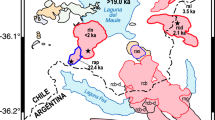Abstract
Observations on phreatomagmatic ash deposits of Phlegraean Fields and Vesuvius supply evidence for the origin of vesiculated tuff in a cool environment. Early deposition by fallout of a matrix-free bed of damp accretionary lapilli is followed by deposition of cohesive mud or a mud rain. The lapilli bed becomes partly or completely transformed into a vesiculated tuff by mud percolation and eventual coalescence of accretionary lapilli with consequent trapping of air originally contained in the interstices. The proposed mechanism accounts for vesiculated tuff formation in distal deposits beyond limits commonly attained by pyroclastic surges. This same mechanism may, nevertheless, also operate in proximal tuff-ring and cone deposits during fallout of phreatomagmatic ash separating bed sets in surge-dominated successions. The sequence of events in the proposed model fits well with the evolution of a cooling phreatomagmatic ash cloud in which early ash aggregation (accretionary lapilli fallout) is followed closely by steam condensation (mud or muddy rainfall). This new model invoking a cool-temperature origin is intended to be complementary to previously proposed theories. Although difficult to assess because of the often complete obliteration of original lapilli, the process is believed to be relatively common in the generasion of vesiculated tuffs within phreatomagmatic deposits.
Similar content being viewed by others
References
Fisher RV, Schmincke H-U (1984) Pyroclastic rocks. Springer-Verlag, Berlin Heidelberg New York Tokyo, pp 1–472
Heiken G (1971) Tuff rings: examples from the Fort Rock-Christmas Lake Valley Basin, South-Central Oregon. J Geophys Res 76:5615–5626
Hoblitt RP, Miller CD, Wallace JW (1981) Origin and stratigraphy of the deposit produced by the May 18 directed blast. In: Lipmann PW, Mullineaux DR (eds) The 1980 eruptions of Mount St. Helens, Washington. US Geol Surv Prof Pap 1250:401–419
Lorenz VW (1974) Vesiculated tuffs and associated features. Sedimentology 21:273–291
Moore JG (1985) Structure and eruptive mechanisms at Surtsey Volcano, Iceland. Geol Mag 122:649–661
Moore JG, Nakamura K, Alcaraz A (1966) The 1965 eruption of the Taal volcano. Science 151:955–960
Teimer TO (1983) Accretionary lapilli in volcanic ash falls: physical factors governing their formation. In: TM Peryt (ed) Coated grains, Springer, Berlin Heidelberg New York, pp 56–68
Rose WI (1977) Scavenging of volcanic aerosol by ash: atmospheric and volcanological implications. Geology 5:621–624 Rosi M, Sbrana A (1987) Phlegrean Fields. Rosi, Sbrana (eds) CNR Quaderni de “La Ricerca Scientifica” Roma 114:9 pp 1–175
Sharp RP, Nobles LH (1953) Mudflows of 1941 at Wrightwood, southern California. Geol Soc Am Bull 64:547–560
Sheridan MF, Wohletz KH (1983) Hydrovolcanism: basic considerations and review. J Volcanol Geotherm Res 17:1–29
Sheridan MF, Barberi F, Rosi M, Santacroce R (1981) A model for plinian eruptions of Vesuvius. Nature 289:282–285
Varekamp JC, Ellen T, Germani M, Buseck P (1986) Particle geochemistry of volcanic plumes of Etna and Mount St. Helens. J Geophys Res 91:12233–12248
Walker GPL (1981) Characteristics of two phreatoplinian ashes, and their water-flushed origin. J Volcanol Geotherm Res 9:395–407
Walker GPL, Croasdale R (1971) Two plinian-type eruptions in the Azores. J Geol Soc London 127:17–55
Author information
Authors and Affiliations
Rights and permissions
About this article
Cite this article
Rosi, M. A model for the formation of vesiculated tuff by the coalescence of accretionary lapilli. Bull Volcanol 54, 429–434 (1992). https://doi.org/10.1007/BF00312323
Received:
Accepted:
Issue Date:
DOI: https://doi.org/10.1007/BF00312323




